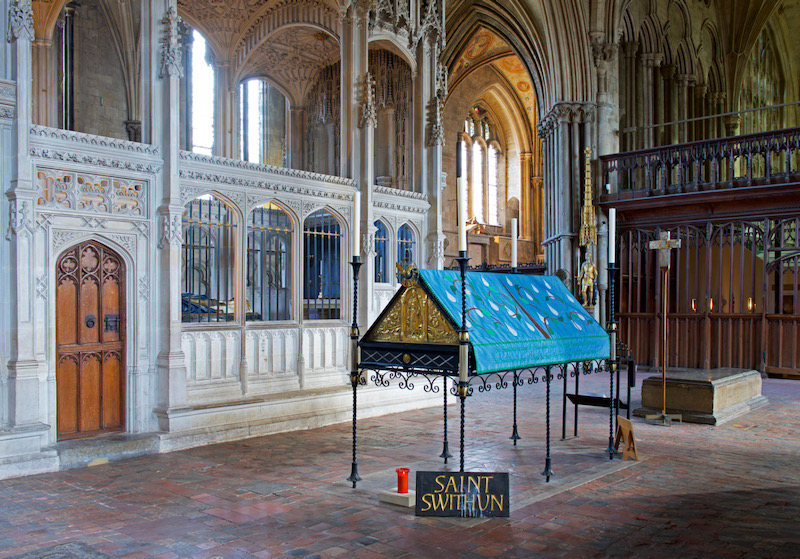It’s St Swithun’s Day, and according to the well-known tradition, the weather on 15 July, be it rain or shine, forecasts what’s in store for us over the remaining six weeks of the British summer. It’s a gobbit of weather-lore, as I’ll explain presently, that goes back to at least the late Middle Ages, when pious pilgrims were flocking to St Swithun’s relics at Winchester Cathedral. I’m also going to tell how the humility, generosity and compassion attributed to Swithun by medieval hagiographers retains the power to move and inspire more than a thousand years after his death, and that there might even be a sound meteorological basis for the purported predictive power of the weather on his mid-July feast.
Swithun was born in the Anglo-Saxon kingdom of Wessex in around the year 800 and was educated at the Old Minster at Winchester. After serving as a royal chaplain, he was appointed bishop of Winchester in 852. Swithun embraced his episcopal duties. He lived humbly, was kind and generous to the poor and was an energetic builder and repairer of churches. Like many other Anglo-Saxon prelates, Swithun had an ear for music, being “euer busy in psalms and spirituell melodye”. He also had a kind heart. The single miracle attributed to Swithun during his lifetime involved the restoration of the broken eggs of a poor woman, shattered when she tripped and fell due to shoddy workmanship while crossing a bridge the bishop had ordered built on the outskirts of Winchester. Swithun died on 2 July 863 and was buried, in accordance with his wishes, in the forecourt of the Old Minster, between its west front and a tower porch dedicated to St Martin.
Swithun’s sanctity became apparent after his death. According to a late tenth-century author, Swithun “resplendent like an angel” appeared in visions to both a “trustworthy” smith and a hunchbacked priest, commanding that his relics be moved or “translated” to a shrine within the Old Minster. It was surely no coincidence that Benedictine monks had recently taken over custody of the cathedral, and the location of the saint’s relics within it would’ve added prestige and glamour. The translation was accomplished amid great ceremony on 15 July 971.
St Swithun’s relics, which were removed from their resting place “limb by limb”, were placed in a magnificent reliquary made of silver, jewels and three hundred pounds of gold, its sides decorated with depictions of Christ’s Passion, Resurrection and Ascension.
The event was accompanied by a host of miracles. In the words of a late medieval author: “The yons of one in prison did brake and the man was delyuered, a man sykevof the palsey was helyd, and xxv other were also made hole of divers sykeness.” Pilgrims flocked to Winchester from far and wide in the hope of benefiting from the saint’s healing grace. This St Swithun liberally bestowed. The cathedral’s monks were ordered by their bishop to assemble in their church to give thanks every time a miracle was reported, their sleep interrupted up to three times in a single night.
In 1093, Swithun’s relics were again translated, this time from the Old Minster to the adjoining new (present) cathedral built by the Normans.The saint’s reliquary on or near the high altar is likely depicted in an early thirteenth-century wall-painting in what’s now the cathedral library. A special door at the juncture of the nave and north transept was built to ease the flow of pilgrims to the shrine. Their number included the greatest in the land. In 1276, King Edward I visited the cathedral “by reason of reverence and prayer for the saint”.
Bits of Swithun’s body and clothing were disseminated across medieval Europe. An arm bone was taken to Stavanger Cathedral, Norway, in 1128 and by the fourteenth century the canons of Évreux Cathedral, France, were claiming his cranium, where it can still be seen to this day.
But the bulk of the saint’s relics remained at Winchester, where they were translated one final time on the 14 July 1476. The Anglo-Saxon reliquary was melted down to make a frontal for the high altar, a new container of gold and silver made to replace it. This was placed atop an elaborate stone superstructure, a contemporary description of events describing how “those prelates who were capable” climbed a ladder to insert the bones into the container “by a certain hatch” made for the purpose.
The shrine lasted little more than fifty years. On 21 September 1538, the henchmen of Henry VIII arrived at Winchester to oversee its destruction. This they accomplished at the dead of night, removing vast quantities of silver and “counterfaictes” stones in the process. St Swithun’s relics were secretly reburied “where ther shall be no cause of superstition giuen by them”.
But memory of Swithun proved hard to suppress, in large part due to our favourite British obsession, the weather. The saint’s 15 July feast has been associated with meteorological phenomena since at least the early fourteenth century. A proverb in a medieval manuscript now at Emmanuel College, Cambridge, states: “In the day of synth Svithone rane ganneth rinigge Forti dawes mid ywone” (On St Swithun’s day it usually starts to rain for forty days). It was a legend known to the playwright Ben Jonson in 1600 and has come down to us as the proverb: “Saint Swithun’s day, if thou be fair, for forty days it will remain; Saint Swithun’s day, if thou bring rain, for forty days it will remain.”
Antiquarians have sought an origin for the proverb in Swithun’s medieval cult, claiming the saint summoned a downpour to show his displeasure at the translation of his relics on 15 July 971. But it’s a claim entirely without any supporting evidence; indeed, as I’ve explained Swithun appeared in visions to command that his relics be moved.
But there might be a scientific explanation. In mid July, the jet stream, a key determinant of weather, settles into a pattern that generally holds until the end of August. It’s St Swithun’s most enduring miracle – a rare and pleasing intersection of the Venn diagrams of hagiography, folklore and meteorology.



 Loading ...
Loading ...
What do you think?
You can post as a subscriber user ...
User comments (0)